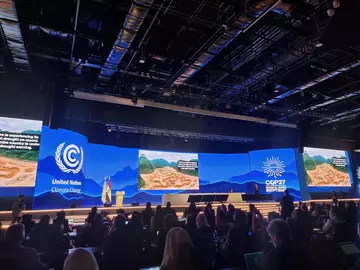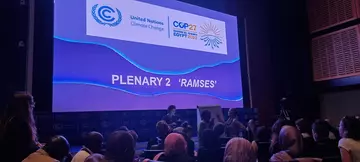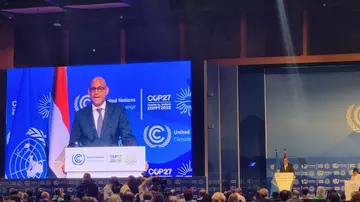Bethan Laughlin
Senior Policy Specialist
Nature-based solutions play a vital role in delivering climate action.
It’s been a week since the COP27 negotiations began, and with another week to go it’s important to explore what progress - if any - has been made. ZSL’s Senior Policy Specialist Bethan Laughlin is representing ZSL at the COP27 negotiations in Sharm el Sheik.
What is a COP?
The UN Framework Convention on Climate Change (UNFCCC) was established in 1982 at the Rio Earth Summit alongside the creation of the Convention on Biological Diversity (CBD) and the Convention to Combat Desertification (CCD).
The UNFCCC came into force in 1994 and is ratified by 198 countries. At the heart of the UNFCCC lies the basic legal framework and principles for international cooperation to collectively tackle climate change. In 2015, under the UNFCCC, The Paris Agreement was passed – a legally binding international treaty on climate change signed by 194 countries with the aim of keeping global temperature rise below 1.5°C
COPs refer to Conference of Parties – usually an annual meeting of all the countries who are signed up to the convention. As the name would suggest, this COP is the 27th meeting of the Conference of Parties, meaning negotiations to address the climate crisis have been taking place for almost 30 years.
Although the three Rio conventions were established together and came into force with the intention of solving the interconnected issues of climate change, biodiversity loss and desertification, in reality the conventions are rather siloed in how they think about and enable solutions. For ZSL, working to breakdown these siloed spaces is integral for the future of effective solutions to these joint crises.
With the CBD’s 15th annual meeting - COP15 - due to take place just a few weeks after the conclusion of COP27, the need for leaders to come together on thinking holistically about the climate and biodiversity crisis has never been more pressing.

What does COP27 mean for climate action?
One of the reasons COP27 has been particularly interesting is seeing how things have changed since COP26 took place in Glasgow last year. COP26 saw the completion of the “rule book” for the Paris Agreement, which sets out the mechanisms and procedures for its activities. With this, the task of negotiating a climate agreement is now broadly over.
At COP27 the colossal task of turning those promises into action has begun.
As such, the major focus of COP27 is rooted in the topic of “implementation”. The Egyptian Government, who are serving as the current COP President, have hailed this meeting as “The Implementation COP” with the tagline of “coming together for implementation” scattered across walls and posters everywhere at the COP27 venue.
The question of climate financing:
At the centre of effective implementation lies another issue – financing. There can be no implementation of climate change solutions without money. As such, many of the negotiations here in Egypt are focused on how the mobilisation of financial commitments can take place, how that money will be used on the ground in mitigating carbon emissions and how countries can adapt to the impacts of climate change.
However, there is a limit to adaptation and this is where the topic of “Loss and Damage” comes into the negotiations. Considered by many to be the third pillar of climate change action - alongside adaptation and mitigation - “Loss and Damage” refers to the economic, social, and environmental harms arising from human-caused climate change.
The destruction of natural systems and commodities are at the centre of Loss and Damage. The natural systems that underpin agriculture, fisheries and many other essential systems are under extreme threat from climate change and are already experiencing major shocks that represent unrecoverable damage for many local communities.
Loss and Damage has been a topic of debate since the creation of the UNFCCC, but after 2022’s climate chaos saw high levels of extreme weather events all over the world, calls from developing countries for action on how they should be compensated for the damage caused by the global north have grown to a fever pitch. Debates by party negotiators about its inclusion at COP27 ran through the night the day before the opening ceremony, but in a moment of real significance, the topic of Loss and Damage Financing was formally added to the agenda for the first time since the establishment of the UNFCCC.

Nature-based Solutions:
As the central tenets of the Paris Agreement, adaptation and mitigation are also major areas of discussion. A key area of work for experts at ZSL is the use of nature-based solutions (NbS) – an approach which both adapts to and mitigates the impacts of climate change. NbS, which include habitat protection and restoration, are low-cost, yet high-impact, and provide multiple benefits to people and wildlife, representing one of the key methods for building climate resilience. ZSL’s Dr Nathalie Pettorelli will be speaking on the role of nature-based climate action in cities and its role in climate resilience as part of a COP27 side event on 16th November.
The implementation of adaptation and mitigation strategies will be reliant on the mobilisation of nature-based solutions and the funds this will require. As the finance focused discussions continue here in Egypt, the results will dictate how fast and at what scale NbS can be rolled out by governments and organisations around the world. When put in place alongside rapid decarbonisation of energy systems, NbS will enable countries to reach their Paris Agreement targets through putting nature at the heart of decision-making.
Conclusion:
Finance is really the lynch pin at this COP. This has been the case for many years, but as the focus has turned to implementation, the spotlight is now on how this can be financed. And these are no small sums. Trillions of dollars of funds will need to be mobilised for the scale of decarbonisation needed to keep the 1.5°C temperature goal within reach.
Discussions on finance are also pivotal for nature, as the mobilisation and implementation of funds for the mass roll out of nature-based solutions will be at the heart of effective decarbonisation, adaptation and resilience building.
With the end of week one of COP27 comes the start of draft texts being submitted for discussion in the various UNFCCC committees for debate between the parties. The next few days either see negotiating groups coming in agreement and alignment on these key issues, or parties leaving disappointed with the scale of ambition and action.
Implementation may be the aim of this COP, but these forthcoming negotiations will test if political ambition can successfully translate into political action.

COP 27, followed by COP 19 in Panama in November and COP15 in Montreal in December, will together put a much-needed spotlight on the decline in global biodiversity.
But without coordinated nature-based policies in place across the world, animals will continue to go extinct, ecosystems will continue to break down and climate change will continue to change life on earth as we know it.
It is vital that governments commit to using nature-based solutions - rooted in science from ZSL and organisations like it - to tackle the combined threats of climate change, biodiversity loss and public health crises.
It is with science that those in power must start: throughout conference season, ZSL is calling for world leaders to put nature at the heart of all global decision-making to better protect ecosystems, wildlife and the communities who rely on them.
Support ZSL's global science and conservation work and find out more
Climate change and human activity have pushed our precious planet to its limit, causing the devastating loss of so many habitats and species. From lab to field, hands on and behind the scenes, we’re leading the future of conservation, shaping agendas and influencing change to support better life, health and living for people and wildlife.
